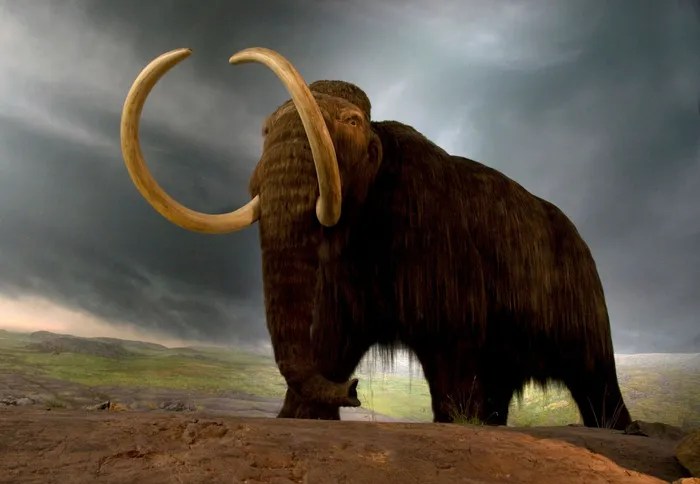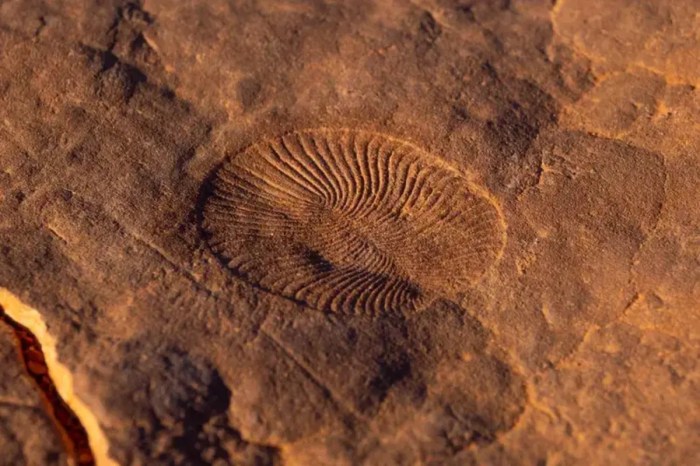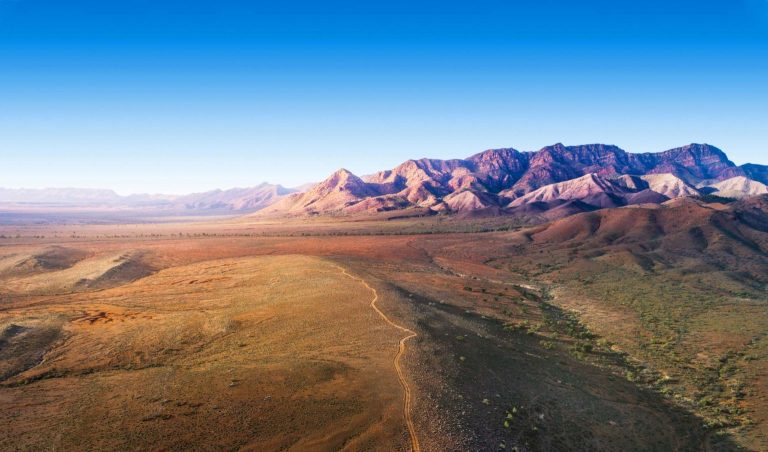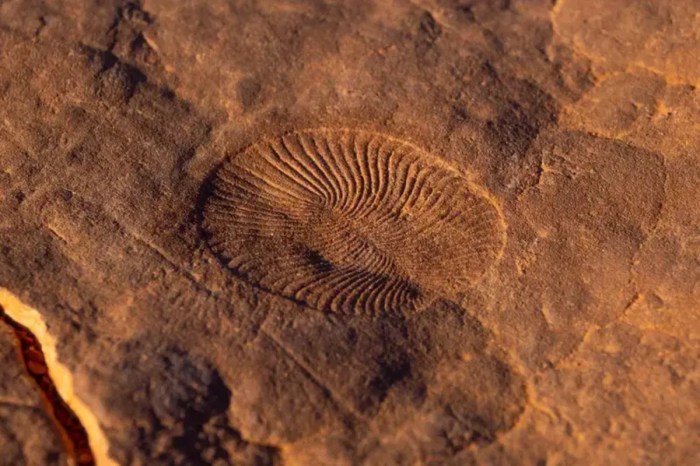Mammoth Cave National Park sets the stage for this enthralling narrative, offering readers a glimpse into a world of subterranean wonders and captivating history. From the park’s remarkable cave system to its diverse ecosystems, this journey promises to be a rich and rewarding exploration. We’ll delve into the park’s unique geological features, the fascinating stories of its discovery, and the vital role it plays in maintaining biodiversity.
The park’s location in central Kentucky, nestled within the scenic landscape of the region, adds to its appeal. Its historical significance as a place of exploration and discovery is woven throughout its story. The park’s extensive cave system, a labyrinth of fascinating formations and passages, awaits exploration. Visitors can delve into the remarkable geological processes that shaped this underground world, from the formations themselves to the unique ecological niches within the cave system.
Introduction to Mammoth Cave National Park
Mammoth Cave National Park, a treasure trove of subterranean wonders, stands as a testament to the power of nature’s artistry and the enduring human fascination with the earth’s hidden depths. This vast cave system, encompassing an intricate network of passages, is a marvel of geological history, boasting a unique ecosystem and cultural significance. Its discovery and exploration have shaped the understanding of both the natural world and human ingenuity.The park’s profound impact on science, exploration, and conservation highlights its importance as a national treasure.
It is a place where visitors can witness the awe-inspiring beauty of the subterranean world, from the towering formations to the diverse wildlife that thrives within its depths.
Geographical Location and Features
Mammoth Cave National Park is situated in central Kentucky, nestled within the region known as the Pennyroyal Plateau. The park’s landscape is characterized by gently rolling hills, woodlands, and the meandering Green River, which acts as a significant boundary and a source of water for the cave system. The unique karst topography of the region, formed over millions of years by the dissolving action of groundwater, has created the ideal conditions for the development of Mammoth Cave.
The park’s geographical position provides a moderate climate, with distinct seasons, supporting a variety of plant and animal life.
Historical Discovery and Development
The history of Mammoth Cave’s discovery is one of gradual exploration and fascination. Early accounts suggest that Native Americans were aware of the cave’s existence, utilizing it for shelter and ritual purposes long before European settlement. The first documented exploration by European settlers occurred in the 18th century, marking the beginning of a long and ongoing journey of discovery and mapping of the cave system.
Subsequent expeditions and mapping efforts revealed the vastness and complexity of the cave’s underground passages, culminating in the establishment of Mammoth Cave National Park in 1941. This designation ensured the preservation of this extraordinary natural wonder for future generations.
Ecological Importance and Biodiversity
Mammoth Cave’s unique subterranean environment supports a fascinating and specialized ecosystem. The cave’s interior is home to a variety of unique cave-dwelling creatures, adapted to the darkness and limited resources. These include various species of bats, insects, and other invertebrates, highlighting the cave’s biodiversity. The park’s surface ecosystem, encompassing forests, grasslands, and riverbanks, complements the cave’s biodiversity, creating a complex and interconnected web of life.
The Green River, a major water source, plays a vital role in maintaining the ecological balance of the surrounding area.
Cultural Significance and Historical Context
The history of human interaction with Mammoth Cave reflects a long and evolving relationship between people and the natural world. The cave’s use by Native Americans, its exploration by early settlers, and its eventual recognition as a national park are all integral parts of its cultural significance. These various layers of history demonstrate the importance of preserving these historical sites.
The park’s ongoing educational programs and research efforts contribute to a deeper understanding of the cave’s past and its place in the wider history of the region. The park serves as a vital educational resource, allowing visitors to learn about the history of exploration and the significance of conservation.
Exploring the Cave System
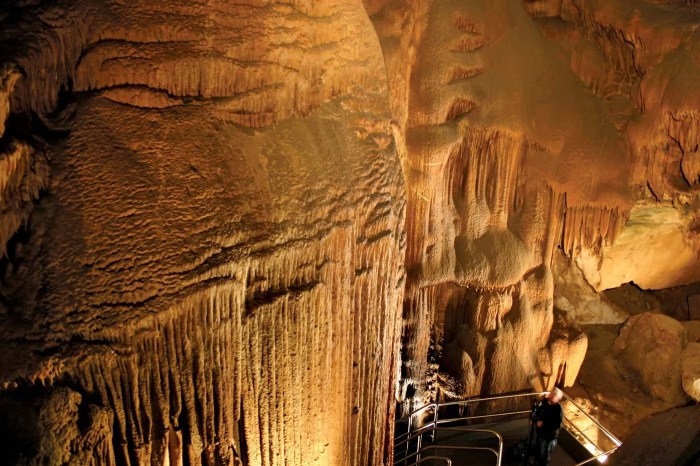
Stepping into Mammoth Cave National Park is like entering a subterranean world, a vast network of passages and chambers sculpted over millennia by the relentless power of water. The cave system’s intricate beauty and geological history are captivating, offering a unique glimpse into Earth’s hidden wonders. Imagine exploring these hidden landscapes, where stalactites and stalagmites intertwine, and the echoing silence is punctuated only by the drip, drip, of water.The formation of Mammoth Cave is a testament to the slow, relentless work of water erosion.
Over vast stretches of time, groundwater, percolating through the surrounding limestone bedrock, dissolved and carved out the cave system. This process, known as solutional erosion, is the primary force behind the cave’s stunning features. The chemical reaction between water and limestone creates a natural etching process that produces the remarkable formations we see today.
Cave Formation and Geological Processes
The creation of Mammoth Cave involved a complex interplay of geological factors. Limestone, a soluble rock, is the primary material. Water, saturated with carbon dioxide from the atmosphere, acts as a powerful solvent, gradually dissolving the limestone. Over eons, this process has sculpted the intricate passages and chambers we observe. The flow of water, influenced by the topography of the surrounding area, played a crucial role in directing the erosion and shaping the cave’s unique layout.
The varying levels of water flow and chemical composition also contribute to the variety of formations.
Remarkable Features
Mammoth Cave boasts an array of stunning features, from towering formations to expansive chambers. These include formations like stalactites, hanging from the ceiling like icy daggers, and stalagmites, rising from the floor like stone pillars. The cave’s intricate passages wind through the earth, often leading to vast chambers, creating a sense of awe and wonder. Within these chambers, you might encounter unusual formations like columns, created by the merging of stalactites and stalagmites, or flowstone, a smooth, layered deposit that often drapes along walls and ceilings.
The sheer scale of these chambers is impressive, with some spanning hundreds of feet in width and height.
Types of Cave Formations
A variety of cave formations add to the beauty and complexity of the cave system. Stalactites, as mentioned before, hang from the ceiling, often exhibiting a variety of shapes and textures. Stalagmites, growing from the floor, are frequently bulbous or conical. Columns, the fusion of stalactites and stalagmites, are often tall and imposing, showcasing the long geological history of the cave.
Flowstone, created by the slow dripping of water, often exhibits patterns and textures, providing a captivating display of nature’s artistry. These formations are constantly evolving, shaped by the ongoing interaction between water and rock.
Popular Cave Tours
Several tours cater to different interests and time commitments. Each tour offers a unique perspective into the cave system.
- The Scenic Tour: This tour provides a comprehensive overview of the cave system, focusing on the major chambers and formations. The length is typically around 2-3 hours.
- The Guided Tour: This tour offers more detailed insights into the cave’s geological history and formations. The length of the tour is often 1-2 hours longer than the scenic tour.
- The Short Tour: This tour is designed for those with limited time, offering a condensed but captivating glimpse into the cave system. It is approximately 1.5 hours.
Cave System Layout
A visual representation of the cave system, such as a detailed map, is essential for understanding its layout and the routes of different tours. This map would show the various passages, chambers, and prominent formations, allowing visitors to plan their exploration effectively. It would be beneficial to include information on the various tour routes on the map for clarity.
Visitor Experience and Activities
Stepping into Mammoth Cave National Park is more than just a visit; it’s an immersive experience into a subterranean world. From the moment you enter the park, you’re surrounded by the awe-inspiring beauty of the cave system and the surrounding landscape. This section will detail the visitor center, available activities, tips for planning, and a sample itinerary to help you plan your unforgettable adventure.The park offers a wealth of activities beyond simply exploring the caves.
Hiking trails wind through the surrounding forest, providing opportunities to witness diverse wildlife and stunning natural scenery. Careful planning, encompassing accommodation and transportation choices, will ensure a smooth and enjoyable trip.
Mammoth Cave National Park is a truly incredible place, filled with fascinating underground caverns. But if you’re looking for a different kind of adventure, exploring the best neighborhoods in NYC, like the trendy Greenwich Village or the historic Lower East Side, is a must-do. These vibrant NYC neighborhoods offer a completely different kind of wonder, with their own unique stories and energy.
Ultimately, whether you’re spelunking in Mammoth Cave or strolling through the streets of the city, the beauty of exploration is what truly matters. best neighborhoods in nyc
Visitor Center Services and Amenities
The visitor center is a crucial hub for visitors. It provides valuable information, maps, and resources for planning your cave exploration and other activities. Staffed by knowledgeable rangers, it’s a valuable resource for all things Mammoth Cave. The center also often hosts exhibits and displays, offering further insights into the cave system and the surrounding ecosystem. The gift shop offers unique souvenirs and educational materials.
Available Activities
Mammoth Cave National Park offers a diverse range of activities. Cave tours are the cornerstone of the experience, meticulously crafted to highlight different aspects of the cave system. Different tour options cater to various interests and experience levels, from guided tours to self-guided exploration.Hiking trails are another compelling way to experience the park. The park’s trails offer opportunities to explore the unique flora and fauna of the region.
Well-maintained trails are available for varying levels of fitness, allowing visitors to appreciate the surrounding natural beauty. Wildlife viewing is a possibility along these trails, where opportunities to spot various species abound.
Planning Your Visit
Booking accommodations in advance is highly recommended, especially during peak seasons. This ensures you secure a comfortable and convenient stay close to the park. Consider lodging options in nearby towns like Cave City or Mammoth Cave. Transportation within the park can be handled by various methods. The park has designated parking areas, making it easy to access trails and tour entrances.
For those who prefer to use their own vehicles, ample parking is available. Rental cars are also a possibility for exploring surrounding areas.
Sample Day Trip Itinerary
This itinerary focuses on a day trip, allowing maximum time for cave exploration.
- Morning (8:00 AM – 12:00 PM): Arrive at the park, visit the visitor center for information and maps. Begin your chosen cave tour, immersing yourself in the wonders of the subterranean world.
- Afternoon (12:00 PM – 4:00 PM): Enjoy a picnic lunch at one of the designated picnic areas within the park. Explore a scenic hiking trail, enjoying the diverse flora and fauna. If time permits, consider a brief wildlife viewing opportunity.
- Late Afternoon (4:00 PM – 5:00 PM): Depart the park, reflecting on your unforgettable adventure.
Visitor Accommodations Comparison
The following table compares various lodging options near Mammoth Cave National Park, highlighting key features.
| Accommodation | Price Range (USD) | Amenities | Proximity to Park |
|---|---|---|---|
| Mammoth Cave Lodge | $100-$250 | Restaurant, Pool, Gift Shop | Very close |
| Holiday Inn Express & Suites | $80-$180 | Restaurant, Pool, Fitness Center | Near |
| Camping Sites | $25-$50 | Campfire, Restrooms, Water | Direct access |
Wildlife and Ecology
Mammoth Cave National Park is a treasure trove of biodiversity, showcasing a fascinating interplay of ecosystems from the surface to the depths of the cave system. Beyond the awe-inspiring caves, a diverse range of plant and animal life thrives in the surrounding forests, wetlands, and streams. Understanding this intricate web of life is crucial to appreciating the park’s significance and the vital role it plays in maintaining ecological balance.The park’s unique ecosystems support a rich array of species adapted to specific conditions.
From the temperate forests to the unique cave environments, each habitat plays a critical role in the park’s overall biodiversity. This complex web of life, carefully balanced over millennia, is the foundation for the park’s ecological integrity.
Plant Life in Mammoth Cave
The park’s plant communities vary considerably based on elevation, soil type, and moisture levels. From the lush canopies of hardwood forests to the more open areas of grasslands, each habitat supports a specific set of plant species. This diverse array of vegetation provides essential food and shelter for a wide range of animal life. The park’s plant life, in turn, contributes to the overall health and resilience of the ecosystem.
Animal Life in Mammoth Cave
The park boasts a diverse range of animal life, including mammals, birds, reptiles, amphibians, and insects. Many species have adapted to the unique challenges and opportunities presented by the park’s diverse habitats. This includes the cave environment, where specialized cave-dwelling creatures thrive.
- Mammals: White-tailed deer, raccoons, opossums, and various species of bats are among the mammals found in the park. These mammals play critical roles in maintaining the balance of the ecosystem, often as prey or predators.
- Birds: A wide variety of bird species, including songbirds, raptors, and waterfowl, utilize the park’s habitats for nesting, foraging, and migration. Their presence contributes to the park’s avian diversity and the overall health of the ecosystem.
- Reptiles and Amphibians: The park’s diverse ecosystems provide habitats for various reptile and amphibian species, playing crucial roles in their life cycles and contributing to the park’s overall biodiversity.
Endangered and Native Species
Mammoth Cave National Park is home to several native and endangered species. Protecting these species is a critical aspect of the park’s conservation efforts. The park’s ecosystems provide vital habitat for these species, contributing to their survival and resilience.
- Endangered Species: The Indiana bat is a critically endangered species found in Mammoth Cave. Its presence highlights the need for careful management of the cave environment and the surrounding habitats.
- Native Species: Many native species, such as the Eastern gray squirrel and the various species of birds, are integral parts of the park’s biodiversity. Their presence and interaction within the ecosystem are essential to its health and resilience.
Conservation Efforts
Mammoth Cave National Park actively engages in conservation efforts to protect its unique ecosystems and the species that inhabit them. These efforts are essential for maintaining the park’s ecological integrity and biodiversity for future generations.
- Habitat Management: The park actively manages habitats to ensure the survival and success of the diverse range of plant and animal life.
- Species Protection: The park works to protect endangered species, such as the Indiana bat, through a variety of conservation strategies.
- Public Awareness: The park educates visitors about the importance of conservation and the park’s ecological value, encouraging responsible behavior.
Biodiversity Role
Mammoth Cave National Park plays a crucial role in maintaining biodiversity. The park’s unique ecosystems support a vast array of species, contributing to the overall richness and resilience of the region’s biodiversity. Its role as a refuge for threatened species underscores its importance for maintaining ecological balance.
History and Culture
Mammoth Cave National Park, a treasure trove of geological wonders, also holds a rich tapestry of human history. From its role in early American exploration to its connection with Indigenous communities and its contribution to cultural preservation, the park’s past continues to resonate in the present. Understanding this history provides a deeper appreciation for the park’s significance and the stories it silently tells.The park’s formation and exploration were intertwined with the development of the nation.
Early explorers, driven by curiosity and a desire for discovery, ventured into the unknown depths of the cave system, revealing its vastness and intricate beauty. This exploration was not merely an act of scientific curiosity but a crucial part of the nation’s burgeoning identity.
Early Exploration and Discovery
The Mammoth Cave system was discovered by early settlers and explorers in the 18th century, with its first documented entrance dating back to 1799. This initial discovery ignited a wave of exploration and fascination, attracting both scientific and popular interest. The cave’s remarkable size and intricate network captivated the imaginations of those who ventured into its depths. This exploration was also part of a broader process of mapping and understanding the American landscape.
Timeline of Significant Events
- 1799: Initial documented entry to the cave system.
- 1800s: Extensive exploration by individuals and groups, leading to the mapping of significant portions of the cave system. These early explorers often documented their experiences, providing valuable insights into the cave’s environment and their own perspectives.
- 1899: Establishment of the Mammoth Cave National Park.
- 1941: The park officially became a national park, ensuring its preservation for future generations. This designation marked a significant milestone in recognizing the park’s immense value to the nation.
- 20th and 21st Centuries: Ongoing research, preservation efforts, and the development of visitor facilities to enhance the experience for visitors. These developments have contributed to the park’s growth as a tourist destination while maintaining its natural and historical integrity.
Connections with Indigenous Communities
Indigenous peoples have inhabited the region for millennia. Mammoth Cave National Park sits within ancestral lands of various tribes, and their connection to the land and the cave system predates European settlement. These communities held deep spiritual and cultural significance to the land and its natural wonders.
Preservation of Cultural Heritage
Mammoth Cave National Park actively strives to preserve and interpret the cultural heritage of the region. This includes maintaining historical records of exploration, preserving artifacts, and presenting information about the Indigenous peoples who inhabited the area before European settlement. This commitment is vital for fostering a comprehensive understanding of the park’s rich past and recognizing the importance of diverse perspectives.
Notable Historical Figures
- Dr. Horace C. Hovey: A prominent geologist and cave explorer who contributed significantly to the early scientific understanding of the cave system. His meticulous mapping and documentation provided a foundation for future research.
- Various early explorers and surveyors: Their explorations and accounts documented the unique features of the cave system, fostering a deeper understanding of the region’s natural wonders and inspiring subsequent explorations.
- Local figures who contributed to the park’s preservation efforts: Their dedication ensured the park’s long-term preservation, reflecting the commitment of individuals and groups in the region.
Planning a Trip: Mammoth Cave National Park
Preparing for a trip to Mammoth Cave National Park requires careful planning to ensure a safe and enjoyable experience. This involves understanding the park’s entry requirements, transportation options, safety protocols, and effective navigation strategies. Knowing the park’s rules and regulations will contribute significantly to a smooth and respectful visit.Obtaining necessary permits and passes is crucial for accessing the park and its various attractions.
Understanding these procedures will help visitors avoid any unforeseen delays or complications. Transportation within the park and parking facilities are important factors to consider when planning your trip. The park’s layout and available transportation options can influence your exploration strategies. Prioritizing safety and following park guidelines ensures a positive and memorable visit for everyone. Learning to navigate the park efficiently helps maximize your time spent exploring this natural wonder.
Obtaining Park Passes and Permits
Visitors need to obtain park passes to enter Mammoth Cave National Park. These passes can be purchased online or at the park entrance. Specific permits may be required for certain activities, such as guided cave tours or overnight stays in designated campsites. Contact the park’s visitor center or website for details on specific permit requirements. These permits ensure visitor safety and maintain the integrity of the park’s resources.
Mammoth Cave National Park is incredible, right? You’ll want to capture all those stunning views, and a good protective phone case is key for any outdoor adventure. To ensure your phone survives the rugged terrain and potential spills, I highly recommend checking out some of the best protective phone cases available. The park’s vast caverns and trails demand a durable companion, and you’ll be glad you’ve got a reliable case for your phone.
After all, you don’t want a busted phone to ruin your Mammoth Cave experience!
Transportation Options and Parking
Mammoth Cave National Park offers various transportation options for exploring the park. Visitors can drive their own vehicles, utilizing the designated parking areas. These areas are strategically located to provide convenient access to trails and cave entrances. Shuttle services are also available for exploring the park. These services are useful for visitors who do not have a car or prefer not to drive.
The shuttle routes are designed to connect key visitor locations. Information about shuttle schedules and routes can be obtained from the park’s visitor center or website.
Safety Precautions and Guidelines
Adhering to safety guidelines is essential for a safe and enjoyable experience at Mammoth Cave National Park. Visitors should be prepared for potential weather changes and wear appropriate clothing. Staying hydrated is important for both your comfort and safety. Carrying a map and a compass, and familiarizing yourself with emergency procedures are crucial precautions. These preparations will help you navigate any unexpected situations.
Visitors should also be aware of wildlife and follow instructions provided by park rangers and staff.
Mammoth Cave National Park is a truly awe-inspiring place, perfect for a long weekend getaway. To really get the most out of exploring its vast network of underground caverns, a sturdy and stylish travel bag is essential. For example, a high-quality leather duffel like the ones featured in style travel bags best leather duffel will keep all your essentials organized and safe during your adventure.
After all, a comfortable and well-equipped trip is key to enjoying the natural wonders of this national park to the fullest.
Navigating the Park and Finding Locations
The park’s layout is designed to facilitate easy navigation. A map of the park is available at the visitor center and online. The park’s website provides detailed information about specific locations, including cave entrances, trails, and visitor centers. This information can assist in planning your route and allocating your time efficiently. Using the park’s map, visitors can locate specific locations easily.
The park’s signage system is designed to guide visitors towards their destinations.
Park Rules and Regulations
| Rule | Description |
|---|---|
| Leave No Trace | Respect the natural environment by minimizing your impact. Pack out all trash and stay on designated trails. |
| Respect Wildlife | Observe wildlife from a distance and never feed or approach them. |
| Fire Restrictions | Follow fire restrictions and obtain permits for campfires, if needed. |
| No Smoking | Smoking is prohibited in many areas of the park. |
| Noise Levels | Maintain reasonable noise levels, particularly during sensitive times. |
| Respect Cave Tours | Follow instructions from tour guides and maintain quiet during cave tours. |
These rules are in place to protect the park’s natural resources and ensure a pleasant experience for all visitors. Following these regulations helps to preserve the integrity of the park’s environment and its natural features for future generations.
Images and Visuals
Mammoth Cave National Park offers a breathtaking visual experience, both above and below ground. The sheer scale and variety of the cave formations, combined with the vibrant wildlife and surrounding landscape, create a rich tapestry of natural beauty. Capturing these moments in photographs and experiencing them firsthand allows for a deeper connection with the park’s wonders.
A Glimpse into the Cave’s Inner Sanctum
Within the labyrinthine depths of the cave, light filters through narrow openings, casting long, dramatic shadows that dance on the cave walls. The interplay of light and shadow creates an ethereal ambiance, transforming the cave into a mystical realm. These subtle variations in light intensity reveal the intricate textures and patterns of the cave formations, highlighting the unique beauty of each space.
The absence of direct sunlight imparts a unique and mysterious quality to the environment.
Cave Formations: Nature’s Artistic Masterpieces
The cave’s formations are truly awe-inspiring. One particular formation, a vast stalactite cascade, hangs suspended from the ceiling. Delicate, almost translucent icicles of calcite, varying in thickness and length, cascade downward in a mesmerizing display. The intricate details of the formation, formed over millennia, are a testament to the slow, powerful forces of nature. These stalactites, along with the accompanying stalagmites, reveal the remarkable processes of mineral deposition and the passage of time.
Wildlife Encounters: A Symphony of Nature
A common sight in Mammoth Cave is the observant bat. Their movements, as they navigate the dark caverns, are surprisingly graceful. Their silent flight through the cave creates a sense of wonder and anticipation. The bats, as they flit about, provide a unique opportunity to witness the subtle yet fascinating details of nocturnal life.
Surrounding Landscapes: A Tapestry of Green
The landscape surrounding Mammoth Cave is characterized by rolling hills and dense forests. Towering trees, such as the majestic hickory and oak, create a canopy of shade, filtering sunlight through their leaves. The undergrowth is a vibrant tapestry of ferns and wildflowers, their colors a stark contrast to the muted tones of the cave. The varied terrain, from the gently sloping hills to the more rugged ravines, creates a diverse and captivating landscape.
Historical Significance of the Entrance, Mammoth cave national park
The historic entrance to Mammoth Cave, with its weathered stone walls and worn pathways, speaks volumes about the park’s rich history. The original entrance, utilized by early explorers and settlers, bears the marks of time and use. These historical markers serve as a reminder of the enduring connection between people and the cave, showcasing the early exploration of the cave system.
The entrance provides a tangible link to the past, a window into the lives of those who came before us.
Last Point
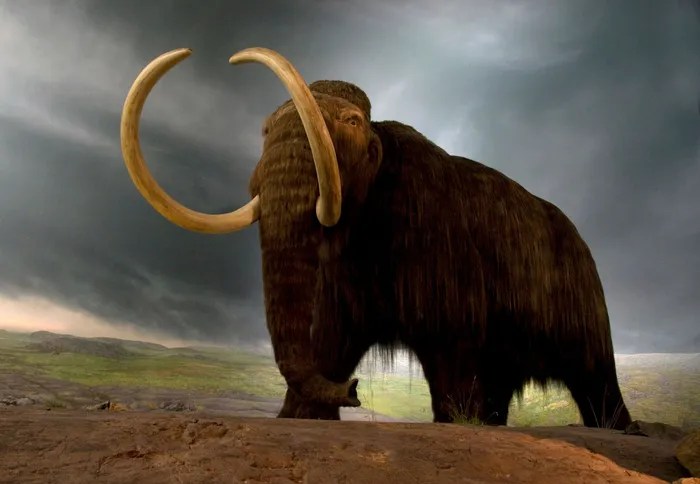
In conclusion, Mammoth Cave National Park stands as a testament to the natural wonders and historical significance of the American landscape. From the awe-inspiring caves to the diverse wildlife and rich history, the park offers a captivating experience for visitors of all interests. This journey has highlighted the importance of preserving these unique ecosystems and the value of understanding their stories.
We hope you’ve been inspired to visit and experience the magic of Mammoth Cave for yourself.
